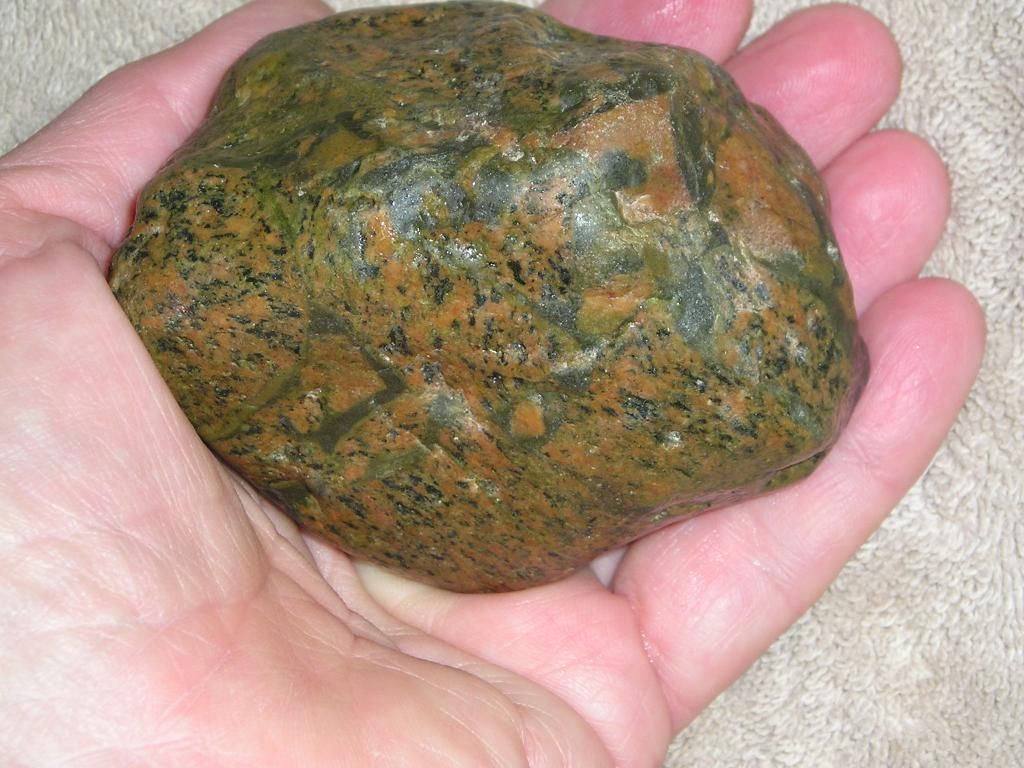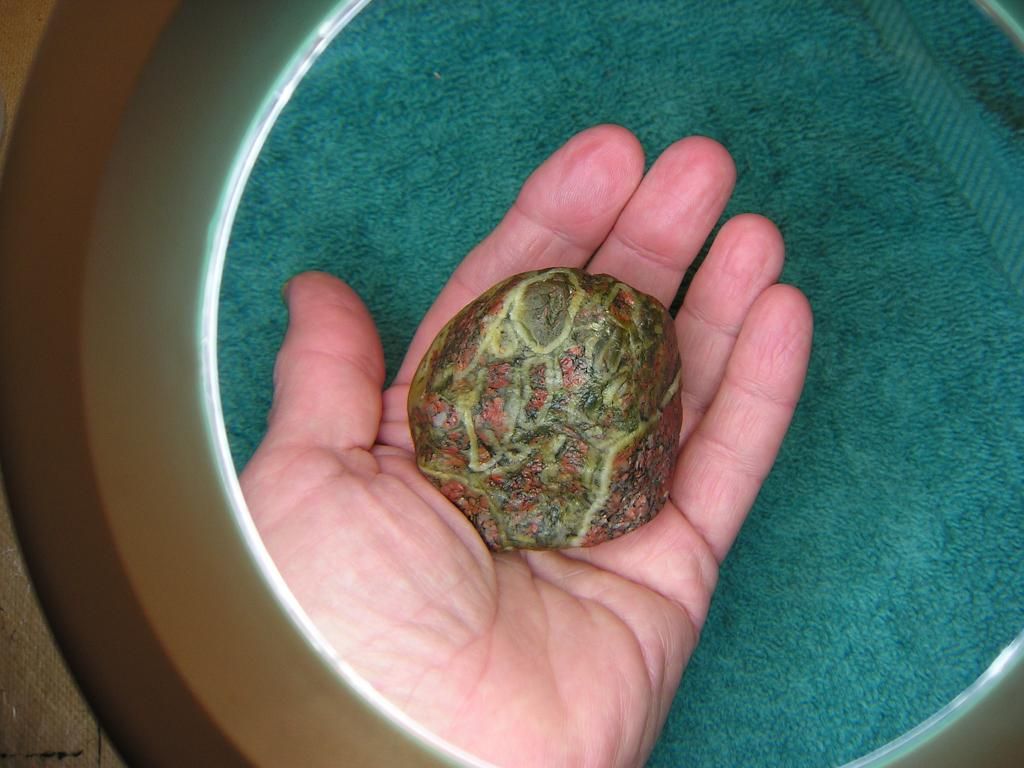Polyhedroid agate (geode)
Mar 5, 2015 12:31:35 GMT -5
rockpickerforever, snowmom, and 1 more like this
Post by gingerkid on Mar 5, 2015 12:31:35 GMT -5
Does anyone have any polyhedroid agate or jewelry pieces designed using polyhedroid agate that they might please post on the forum?
(edited to add) Just found a couple of threads on the forum with pics of polyhedroids.
One from parfive
forum.rocktumblinghobby.com/thread/24440/wonderful-world-agates-show
and a beautiful bobby1 polyhedroid segment cabochon
forum.rocktumblinghobby.com/thread/37779/more
An excerpt on polyhedroids -
Polyhedroids: An Introduction to Very Strange Geodes
By Jim Elliot, Indian Mounds RMC
from Arrowhead News, newsletter of Indian Mounds Rock & Mineral Club, Nov. 2008
"Polyhedroids are filled in, like your typical geode, with agate bands and quartz crystals but the angular and linear appearance certainly make you wonder where nature
went astray.
No one is absolutely certain about how these geodes were formed, since their shapes do not match any crystal structures of various minerals that the agate may have replaced. The unique aspect of polyhedroid geodes is that their cavities are very angular and geometric, not round and symmetrical like the typical nodular appearance of most agates and geodes.
The most agreed upon formation theory is that the sharp geometric lines are thought to be the result of the geode forming in the interstices between tabular crystals of calcite. In other words, the geodes formed in the somewhat randomly shaped angled spaces between
calcite crystal formations. Over time silica replaced the calcite, resulting in the wonderful flat faces we see today. Silica then filled the cavity between the calcite lattice spaces, in the typical geode formation process similar to that of gas bubble geode development.
The geodes themselves are often hollow and the best quality polyhedroids feature sharp, colorful fortification agate bands that follow the typically triangular or trapezoidal
shape of the pseudomorph. Most polyhedroid geodes are quartz. They have cream, pale brown, to dark gray flat faces. The number of faces ranges from five to ten or
more. Black, gray, and white seem to be most common colors of the Polyhedroid geodes. Shapes can be a variety of well defined geometric forms.
The formation of these geodes is still a topic of discussion among geologists. Polyhedroids were first found in the clay deposits formed from the decomposition of rock matrix, so all of the traces of their geologic past are gone. Polyhedroid geodes are from Brazil, and were found in only one locale in Paraiba, a small state in the northeast coast of Brazil. These unique geodes were discovered in 1974. These distinctive specimens were only available for a very short time and are extremely difficult to locate today, since no new material has been produced since then. They were very popular used as jewelry items in the 1970s."
Bibliography: Cross, Brad L. and Zeitner, June Culp,
Geodes – Nature’s Treasures, Gem Guides Book Co.,
Baldwin Park, California, 2006
I have one polyhedroid display piece and a couple of polyhedroid slabs that are in the collection.

Polyhedroid agate

slabs:

This one is amethyst polyhedroid slab
seller's pic

Bytroidal in amethyst polyhedroid slab
seller's pic
here's a pic where i tried to polish it, lol

have a couple of slabs that are broken, like this one


(edited to add) Just found a couple of threads on the forum with pics of polyhedroids.
One from parfive

forum.rocktumblinghobby.com/thread/24440/wonderful-world-agates-show
and a beautiful bobby1 polyhedroid segment cabochon

forum.rocktumblinghobby.com/thread/37779/more
An excerpt on polyhedroids -
Polyhedroids: An Introduction to Very Strange Geodes
By Jim Elliot, Indian Mounds RMC
from Arrowhead News, newsletter of Indian Mounds Rock & Mineral Club, Nov. 2008
"Polyhedroids are filled in, like your typical geode, with agate bands and quartz crystals but the angular and linear appearance certainly make you wonder where nature
went astray.
No one is absolutely certain about how these geodes were formed, since their shapes do not match any crystal structures of various minerals that the agate may have replaced. The unique aspect of polyhedroid geodes is that their cavities are very angular and geometric, not round and symmetrical like the typical nodular appearance of most agates and geodes.
The most agreed upon formation theory is that the sharp geometric lines are thought to be the result of the geode forming in the interstices between tabular crystals of calcite. In other words, the geodes formed in the somewhat randomly shaped angled spaces between
calcite crystal formations. Over time silica replaced the calcite, resulting in the wonderful flat faces we see today. Silica then filled the cavity between the calcite lattice spaces, in the typical geode formation process similar to that of gas bubble geode development.
The geodes themselves are often hollow and the best quality polyhedroids feature sharp, colorful fortification agate bands that follow the typically triangular or trapezoidal
shape of the pseudomorph. Most polyhedroid geodes are quartz. They have cream, pale brown, to dark gray flat faces. The number of faces ranges from five to ten or
more. Black, gray, and white seem to be most common colors of the Polyhedroid geodes. Shapes can be a variety of well defined geometric forms.
The formation of these geodes is still a topic of discussion among geologists. Polyhedroids were first found in the clay deposits formed from the decomposition of rock matrix, so all of the traces of their geologic past are gone. Polyhedroid geodes are from Brazil, and were found in only one locale in Paraiba, a small state in the northeast coast of Brazil. These unique geodes were discovered in 1974. These distinctive specimens were only available for a very short time and are extremely difficult to locate today, since no new material has been produced since then. They were very popular used as jewelry items in the 1970s."
Bibliography: Cross, Brad L. and Zeitner, June Culp,
Geodes – Nature’s Treasures, Gem Guides Book Co.,
Baldwin Park, California, 2006
I have one polyhedroid display piece and a couple of polyhedroid slabs that are in the collection.

Polyhedroid agate

slabs:

This one is amethyst polyhedroid slab
seller's pic

Bytroidal in amethyst polyhedroid slab
seller's pic
here's a pic where i tried to polish it, lol

have a couple of slabs that are broken, like this one


















